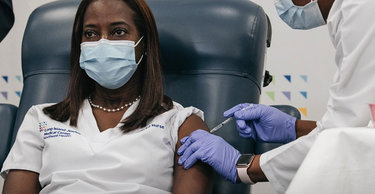First COVID vaccines given, Albany County not named yellow zone
ALBANY COUNTY — On Monday, the day a few New Yorkers got the first COVID vaccinations, Albany County escaped being named a yellow precautionary zone.
Governor Andrew Cuomo announced on Monday that new yellow zones were established in Genesee and Oneida counties and the yellow zone in Niagara County has been expanded.
Last month, based on the state’s metrics for COVID-19 infection rates, Albany County had been on the cusp of being named a yellow zone when Cuomo outlined his winter plan for micro-cluster zones, which shifted the focus to hospital capacity.
COVID-19 rates have risen across the state and across the nation with the onset of cold weather and holiday travel and gatherings.
New York, rather than shutting down regional economies, has adopted a micro-cluster approach, defining red zones, with the heaviest outbreaks of the virus and the most severe restrictions, followed by orange warning zones and yellow precautionary zones.
On Friday, Cuomo had outlined the new criteria for defining the three zones and said numbers would be crunched over the weekend to announce new zones on Monday.
An area is eligible to enter a yellow zone if it has a 3-percent positivity rate (seven-day average) over the past 10 days and is in the top 10 percent in the state for hospital admissions per capita over the past week and is experiencing week-over-week growth in daily admissions.
On Monday, Cuomo did not discount an entire shutdown if numbers don’t improve. “If we do not change the trajectory, we could very well be headed to shutdown,” he said.
Vaccines
The first vaccines for COVID-19 were administered on Monday, including locally to high-risk health-care workers at Albany Medical Center.
New York State, based on population, is slated to get 170,000 doses of the vaccine approved by the Food and Drug Administration on Friday for emergency use, made by Pfizer and BioNTech.
Albany County Executive Daniel McCoy said at his Monday morning press briefing that the state hopes to get 350,000 doses of vaccine from Moderna by the end of December, which Cuomo confirmed at his press conference later in the day at 346,000 doses.
McCoy noted, though, that it will take months to vaccinate enough of New York’s 19 million residents to have life return to normal.
Cuomo made a similar point, estimating it would take six to nine months to get a critical mass inoculated.
“The big ‘if’ is, you need 75 to 85 percent critical mass and you have 49 percent of the people who are skeptical about taking it ..,” said Cuomo. “We have to educate the public. We have to outreach to all communities, Black, Latinos, poor communities, that have paid the highest price for this virus, and we have to get it out. We have to distribute it; it is a logistical operation like you’ve never seen before, which we’re already working on.
On Monday morning, Sandra Lindsay, a frontline health-care worker at Long Island Jewish Medical Center in Queens, got the first vaccination in New York State and, Cuomo speculated, perhaps the nation.
Lindsay said she felt hopeful and relieved. “I feel like healing is coming and this marks the beginning of the end of a very painful time in our history,” she said. “I want to instill public confidence that the vaccine is safe.”
Newest numbers
Another Albany County resident — a woman in her eighties — died of COVID-19 overnight, McCoy announced on Monday morning, bringing the county’s death toll from the disease to 181.
He noted that earlier this week two residents in their fifties had died of COVID-19. “When you start to see that number go down, it’s alarming,” he said of the age of victims of COVID-19.
As of Monday morning, Albany County has had 7,951 confirmed cases of COVID-19, with 154 new cases since Sunday, McCoy announced.
Of the new cases, 14 had close contact with someone infected with the disease, 138 did not have a clear source of infection identified at this time, one reported traveling out of state, and one is a health-care worker or resident of a congregate setting.
The five-day average for new daily positives decreased to 182 from 188.4. There are now 1,639 active cases in the county, up slightly from 1,636 on Sunday.
The number of county residents under mandatory quarantine increased to 3,244 from 3,082. So far, 28,217 residents have completed quarantine. Of those, 6,312 had tested positive and recovered.
There were 11 new hospitalizations reported overnight, and there are 86 county residents currently hospitalized from the virus — a net increase of six — with 13 patients under intensive care, up from 12 yesterday.
McCoy stressed that not all of the hospitalized patients are elderly. Currently, two of the Albany County patients hospitalized with COVID-19 are under 25; McCoy said one of them was 17. Twelve are between the ages of 25 and 49; forty are between the ages of 50 and 74; and 32 are over the age of 75.
Statewide, the positivity rate, based on Sunday’s test results, was 5.66, according to numbers released by the governor’s office.
The Capital Region, of which Albany County is a part, had a rate on Sunday of 5.89. Of the state’s 10 regions, the Southern Tier continued to have the lowest positivity rate, at 2.65, while the Finger Lakes had the highest rate, at 8.09 percent.
The Capital Region currently has 269 patients hospitalized with COVID-19, which is 0.02 percent of the region’s population, and leaves 25 percent of the region’s hospital beds available.
Statewide, 0.03 percent of New Yorkers are hospitalized with the disease and 23 percent of New York’s hospital beds are available.
The Capital Region has 269 beds in intensive-care units; currently, 171 of them are occupied, leaving 42 percent available. Statewide 33 percent of ICU beds are available.



